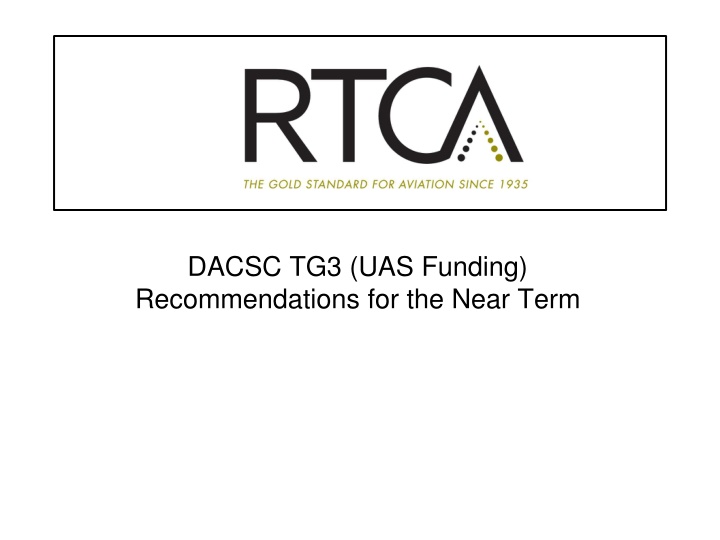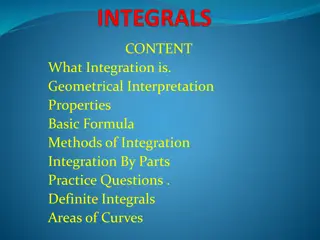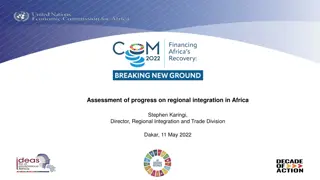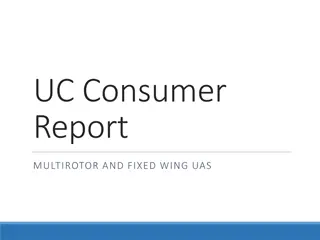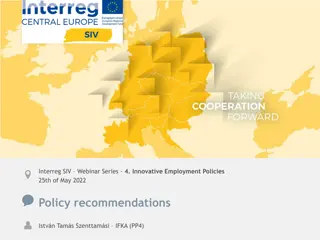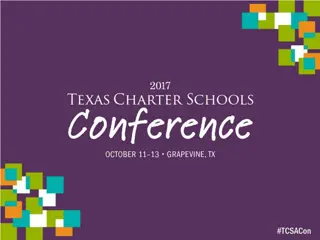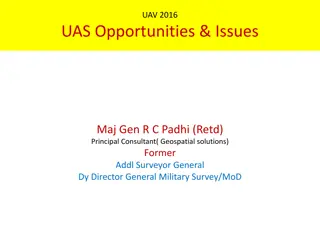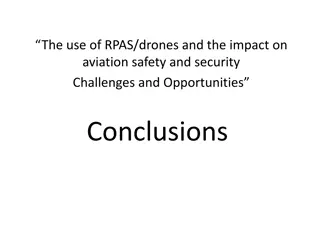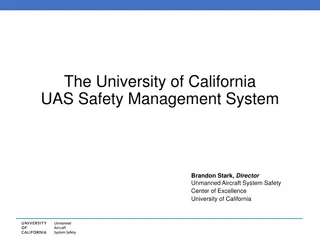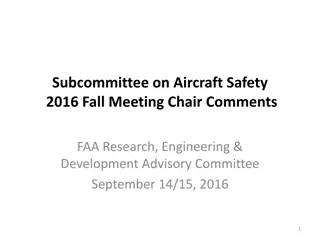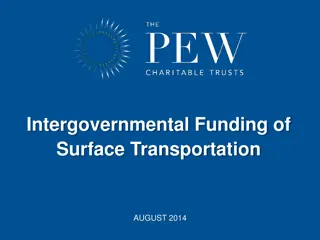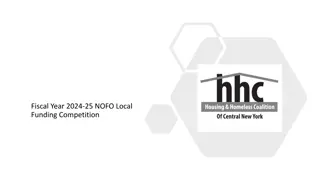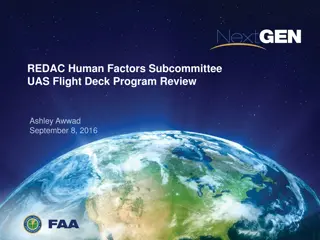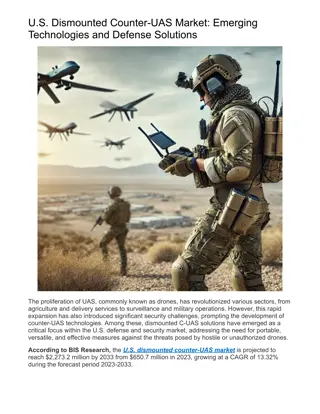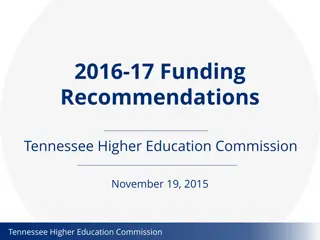UAS Funding Recommendations for Successful Integration
The future success of the drone industry relies heavily on government and private sector funding. The DACSC TG3 provides recommendations for near-term funding to support drone integration into the National Airspace System (NAS). Guiding principles prioritize a combination of funding sources and emphasize safety, operations readiness, and economic benefits. Methodology using the Analytic Hierarchy Process (AHP) ranked FAA UAS activities based on safety, operations, and economic criteria. Recommendations include prioritizing BVLOS operations, technology standards, network capabilities, and regulatory programs for commercial UAS operations.
Download Presentation

Please find below an Image/Link to download the presentation.
The content on the website is provided AS IS for your information and personal use only. It may not be sold, licensed, or shared on other websites without obtaining consent from the author.If you encounter any issues during the download, it is possible that the publisher has removed the file from their server.
You are allowed to download the files provided on this website for personal or commercial use, subject to the condition that they are used lawfully. All files are the property of their respective owners.
The content on the website is provided AS IS for your information and personal use only. It may not be sold, licensed, or shared on other websites without obtaining consent from the author.
E N D
Presentation Transcript
DACSC TG3 (UAS Funding) Recommendations for the Near Term
Background Future success of the drone industry depends on government and private sector funding to support and facilitate the integration and operations of drones in the NAS. The FAA requires new resources to be devoted to this task. The FAA asked the DAC to provide near term funding recommendations by July 2017, and longer term recommendations by March 2018. TG3 was established to provide these recommendations. 2
Assumptions and Guiding Principles TG3 agreed to the following guiding principles: There will be a combination of government, industry, and shared funding across the integration efforts. Options for funding should not be constrained by the current traditional aviation funding structure, although in the near-term a new model may be difficult to implement. The recommended funding structure should not alter the current structure of funding for traditional, manned aviation. 3
Methodology We used the analytic hierarchy process (AHP) via Decision Lens to rank all FAA UAS activities against a comment set of criteria. Safety among UAS operators, for people and property on the ground, and with current manned aviation, given a 60% weight. Enabling operations and technological readiness, given a 28% weight. Economic benefits to society and the government, given a 12% weight. The vast majority of members participated in the rating and ranking process. 4
Decision Lens Results A prioritized list of FAA activities
Work Flow The group validated the results and divided into teams. Each team worked through their prioritized results to define the short-term government, industry, and collaborative efforts to fund these activities and provided written recommendations. The reports were circulated and discussed, and consensus was reached on the recommendations. The groups also used the recommendations from TG2 to ensure there was common guidance across all three work groups: Prioritization of UAS BVLOS operations within the Mode C Veil below 400 ft. AGL Development of technology neutral navigation performance requirements Evaluation of the ability of existing networks to meet low altitude UAS C2 requirements Establishment of a FAR Part 135 regulatory pathfinder program for commercial UAS low-altitude BVLOS operations 7
Recommendations All regulations, policies, and standards necessary in the next 24 months should be developed primarily by the FAA with significant industry input. We recommend that Congress appropriate additional funding and increase FAA staffing to address this ambitious work schedule. The research and development, and system development necessary in the next 24 months, should be shared between government and industry. Communications, outreach, and training necessary in the next 24 months should be shared between government and industry, depending on the activity. Any recommended funding structure should not alter the current structure of funding for traditional, manned aviation. In the future, the UAS industry may be expected to pay for the operation, maintenance, and modernization of an automated Unmanned Traffic Management (UTM) system through a yet-to-be-created pay-for-what-you-use funding model. 8
Regulations Costs for these priority efforts should be primarily bourn by the FAA. These rules include: Operations Over People (OOP) Identification and Tracking Section 2209 Designation of prohibited/restricted airspace over fixed-site facilities Counter-drone Operations and Activities Expanded Operations (BVLOS, package delivery) Air Carrier Certification and Operations UAS Fee Structure 9
Policies and Standards Costs for these priority efforts should be shared, depending on activity: Flights Standards Policies Air Traffic Control Policies Operator Policies Airports Policies Pilot Certification and Qualification Standards Airworthiness Certification Standards Command and Control Standards Detect and Avoid Standards 10
Systems and R&D Costs for these priority efforts should be shared, depending on activity: LAANC Related R&D Activity: Air Traffic Management, C2 & Spectrum, Separation Related Systems Activity: Traffic Management System, Authorization Portal, ATC Systems/Capabilities, CNS Systems, Registration System, Spectrum Management IT Gateway Related R&D Activity: Air Traffic Management, Separation Related Systems: Traffic Management System, Authorization Portal, CNS Systems: Registration System UTM Related R&D Activity: Air Traffic Management, C2 & Spectrum, Separation, Human Factors, Environmental Related Systems: Traffic Management System, Authorization Portal, ATC Systems/Capabilities, CNS Systems, Registration System, Spectrum Management 11
Outreach and Training Costs for these priority efforts should be shared, depending on activity: Training Air Traffic Control Training Flight Standards Training Airports Training AVS/AOV Oversight Training Outreach and Communication 12
Activity and Funding List Priority Activity Lead Funding 1 Pilot Certifications/Qualifications Gov t. & Ind. 2 Air Traffic Management R&D Gov t. & Ind. 3 Flight Standards Policies/Procedures Government 4 Air Traffic Controls - Policies/Procedures Government 5 Injury Severity R&D Govt. & Ind. 6 Rulemaking Government 7 C2 & Spectrum R&D Gov t. & Ind. 8 Separation Gov t. & Ind. 9 DAA Standards Gov t. & Ind. 10 Traffic Management System Gov t. & Ind. 11 Airports - Policies/Procedures Government 12 Outreach/Communication Gov t. & Ind. 13 Airworthiness Certification Gov t. & Ind. 14 Authorization Portal Gov t. & Ind. 15 Operators Government 16 ATC Systems/Capabilities Gov t. & Ind. 17 C2 Standards - Standards Gov t. & Ind. 18 CNS Systems Gov t. & Ind. 19 Air Traffic Control - Training Gov t. & Ind. 20 Flight Standards - Training Gov t. & Ind. 21 Human Factors R&D Gov t. & Ind. 22 Airspace Charting Government 23 Registration System Government 24 Size/Impact Energy Government 25 Spectrum Management Government 26 AVS/AOV Oversight Government 27 Airports - Training Government 28 Environmental R&D Gov t. & Ind. 29 Environmental - Standards 14 Government
FAA Reauthorization and Appropriations FY17 FAA UAS Budget: +$20M for ATO, +$10M for AVS, and +$2.67M for R&D (based on the FY17 President s Budget request). Authority for these funds runs through FY18. Significant portions of the House and Senate s FAA Reauthorization bills are dedicated to UAS. Many of the provisions come with new rulemaking and reporting requirements, which will strain already limited FAA budgetary resources. 15
Whats Next for TG3? The long term questions are more complicated. Cost accounting measures? TG3 will consider options and identify self-sustaining and scalable funding sources that allow all users of the NAS to fund the necessary resources to ensure its safe and efficient operation. TG3 will work to identify a funding option for the UAS industry that is segregated from the system that funds manned aviation. The funding mechanism should be flexible enough to support potential far-reaching structural changes to FAA funding and activities. TG3 will consider new sources of funding for the long term, including user fees or similar pay-for-what-you-use services. 16
Listening Session TG3 had a listening session on long-term issues on July 14th. It was open to the entire DAC SC, for as many options and voices to heard. What we heard. 17
Questions? 18
Informing our Workflow FAA UAS Integration . . . . .. 2016 Registration& Part107 2017 Security &UAS OverPeople 2018 2019 2020 2025 Integrated Operations Small CargoOperations ExpandedOperations Capital Investments &Automation Segregation Ongoing Maintenance $$ UTMImplementation (full dataexchange) LAANCPre- Implementation $$ LAANC Implementation/ UTM Pre-Implementation Integrated Gateway & Data WarehouseDevelopment Integrated GatewaySustainment + AdditionalModules $ Registration, WaiverPortal Medium / Large UAS Integration Pre-Implementation (R&D) Medium / Large UAS Integration Implementation Integration $$ ATM Updates ERAM, STARS, NAS Voice Switch Development of Minimum Performance Standards Policy, Coordination, &Operations ATO, AVS Manual Processing ofAuthorizations (e.g. waivers, airspace authorizations,COAs) $ Program and ActivitySupport (e.g. rulemaking, safety standards, policy development, enforcement, security, outreach, etc.) All FAA $
Informing our Workflow FAA Definitions Policies and Procedures: Procedures that must be developed for air traffic control facilities, such as ARTCCs and other Air Traffic Management personnel, UAS operators, manufacturers, and other airspace users, to enable the operational milestones. Specific policies/procedures to be developed or updated include: Flight Standards, Air Traffic Controls, Operator Policies, Airport Policies, and Airspace Charting. Rulemaking: Key rulemaking activities needed to enable the milestone, as well as any relevant public law changes associated with the milestone that may be needed or expected. Standards: Standards needed to guide technical and operational aspects of the operational milestone; e.g., detect and avoid, pilot certification, aircraft and control station certification standards. Specific examples include: Pilot Certifications/Qualifications, DAA Standards, C2 Standards and Environmental Standards. Outreach/Communication: Any major outreach and communications efforts with the public, UAS stakeholders, other airspace users, Tribal Governments, or oversight organizations such as Congress, required to support safe implementation of the operational milestone, including a process to address concerns that may come up from communities, interest groups and individuals as UAS are integrated into the NAS Training: Any training of the FAA workforce that will be needed to enable the UAS activity. Specific examples of training include: Air Traffic Control Training, Flight Standards Training, AVS/AOV Oversight training and Airports Training. R&D: All R&D activities needed to determine solutions to unresolved or potential issues associated with that operational milestone; e.g., supporting performance-based requirements or safety analyses for Detect and Avoid (DAA). Specific R&D examples include: Air Traffic Management, Injury Severity, C2 and Spectrum, Separation, Human Factors, and Environmental Research. Systems: Any infrastructure development or modification needed to enable the operational milestone; e.g., ATC systems, communications, navigation, and surveillance (CNS) infrastructure, and UAS operator support systems such as the registration system. Specific examples of FAA Systems include: Traffic Management System, Authorization Portal, ATC Systems/Capabilities, CNS Systems, Registration System, and Spectrum Management. 20
